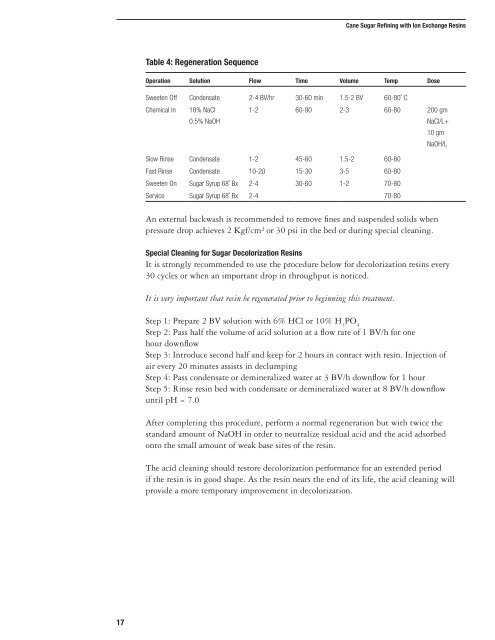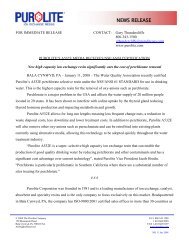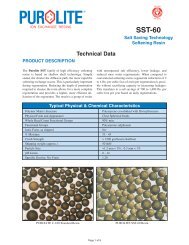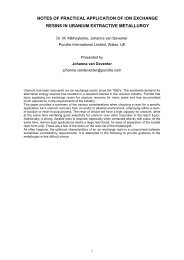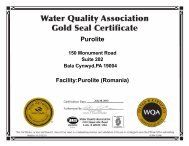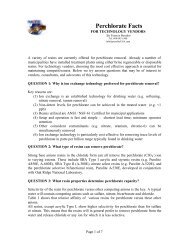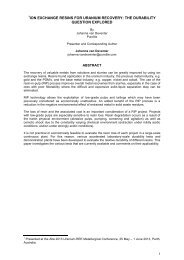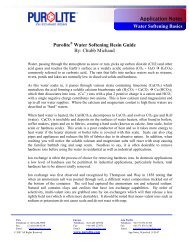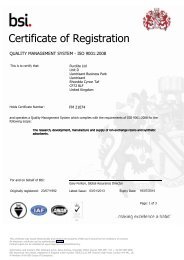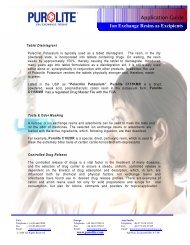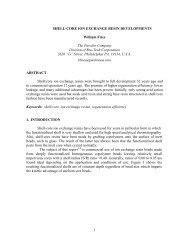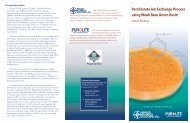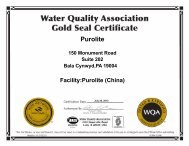Cane Sugar Refining - Purolite
Cane Sugar Refining - Purolite
Cane Sugar Refining - Purolite
Create successful ePaper yourself
Turn your PDF publications into a flip-book with our unique Google optimized e-Paper software.
17<br />
Table 4: Regeneration Sequence<br />
<strong>Cane</strong> <strong>Sugar</strong> <strong>Refining</strong> with Ion Exchange Resins<br />
Operation Solution Flow Time Volume Temp Dose<br />
Sweeten Off Condensate 2-4 BV/hr 30-60 min 1.5-2 BV 60-80˚ C<br />
Chemical In 10% NaCl 1-2 60-90 2-3 60-80 200 gm<br />
0.5% NaOH<br />
NaCl/L+<br />
10 gm<br />
NaOH/L<br />
Slow Rinse Condensate 1-2 45-60 1.5-2 60-80<br />
Fast Rinse Condensate 10-20 15-30 3-5 60-80<br />
Sweeten On <strong>Sugar</strong> Syrup 68˚ Bx 2-4 30-60 1-2 70-80<br />
Service <strong>Sugar</strong> Syrup 68˚ Bx 2-4 70-80<br />
An external backwash is recommended to remove fines and suspended solids when<br />
pressure drop achieves 2 Kgf/cm² or 30 psi in the bed or during special cleaning.<br />
Special Cleaning for <strong>Sugar</strong> Decolorization Resins<br />
It is strongly recommended to use the procedure below for decolorization resins every<br />
30 cycles or when an important drop in throughput is noticed.<br />
It is very important that resin be regenerated prior to beginning this treatment.<br />
Step 1: Prepare 2 BV solution with 6% HCl or 10% H 3 PO 4<br />
Step 2: Pass half the volume of acid solution at a flow rate of 1 BV/h for one<br />
hour downflow<br />
Step 3: Introduce second half and keep for 2 hours in contact with resin. Injection of<br />
air every 20 minutes assists in declumping<br />
Step 4: Pass condensate or demineralized water at 3 BV/h downflow for 1 hour<br />
Step 5: Rinse resin bed with condensate or demineralized water at 8 BV/h downflow<br />
until pH = 7.0<br />
After completing this procedure, perform a normal regeneration but with twice the<br />
standard amount of NaOH in order to neutralize residual acid and the acid adsorbed<br />
onto the small amount of weak base sites of the resin.<br />
The acid cleaning should restore decolorization performance for an extended period<br />
if the resin is in good shape. As the resin nears the end of its life, the acid cleaning will<br />
provide a more temporary improvement in decolorization.


